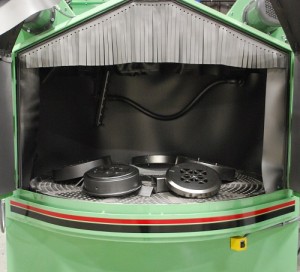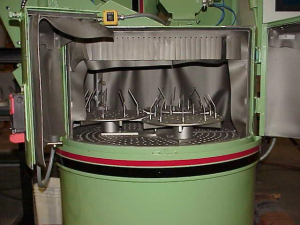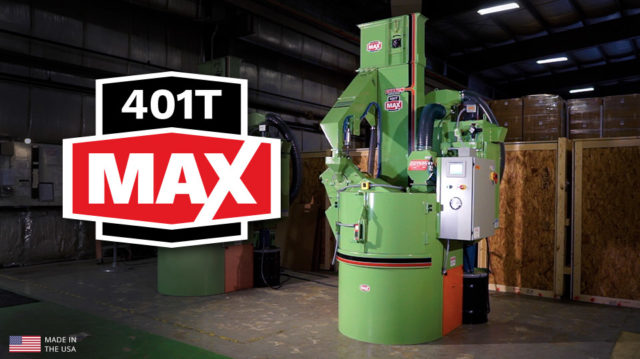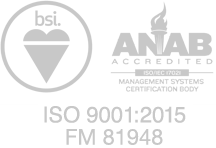When a wheel blasting machine with the right media can do the work and meet your production requirements, it is usually the lowest-cost alternative for repetitive cleaning or surface finishing.
Energy Savings
 One reason wheel machines are more economical than air blast equipment is energy efficiency. This is a hot issue for many companies right now, as they look for ways to reduce their carbon footprint and lower their operating costs. Compared to multiple manual blast cabinets that draw volumes of compressed air many hours per day or a multi-gun air blast machine, a wheel-blast system delivers a major reduction in energy consumption.
One reason wheel machines are more economical than air blast equipment is energy efficiency. This is a hot issue for many companies right now, as they look for ways to reduce their carbon footprint and lower their operating costs. Compared to multiple manual blast cabinets that draw volumes of compressed air many hours per day or a multi-gun air blast machine, a wheel-blast system delivers a major reduction in energy consumption.
Wheelblast systems are sometimes called “airless” blast machines because they do not use compressed air to accelerate the blast media. Instead, a paddle-bladed wheel or turbine throws the bead, and the machine’s usage of air is intermittent, limited to pneumatic actuator and blow-off functions.
To quantify the potential energy savings compared to air blasting, consider that for every 100 cubic feet per minute of air, you use about 25 horsepower (18.6 kilowatts) of air compressor capacity. The total installed horsepower of Guyson’s most popular wheel machine, the GWB-401T including its integral cartridge dust collector, is 7.75 HP (5.7 kw).
Media Savings
Blast media consumption is another operating cost where dramatic savings can be realized by converting to wheel-blast equipment. The most common material used for non-abrasive blast cleaning in air-blast cabinets is glass bead media. Even when blast pressures are kept under 50 psi, the fracture rate of glass beads results in frequent additions of fresh media to compensate and maintain the operating mix. It is not uncommon for a single cleaning or finishing application to go through thousands of pounds of glass beads per year, especially when multiple air-blast cabinets are used on multiple shifts.
By contrast, wheel machines use metal media, and Guyson wheel-blast systems are specially adapted to allow the use of microscopic bead. Some of these fine metallic media are soft and low in aggression for nondestructive cleaning, others are harder and capable of producing an attractive glass-bead-like finish, but both of these media types do not fracture, wear down gradually and have a very long service life.
Typical of the savings on media with a Guyson wheel-blast machine is the mold shop in a glass container plant that averaged 2,000 pounds of glass beads per month in 3 manual blast cabinets before installation of a GWB-401T mold cleaning system and 250 pounds per year after.
Time and Labor Savings
 Cleaning or finishing in a rotary table wheel-blast machine is a batch process. As many components as you can spread out on the turntable or hang on part-holding fixtures will normally be thoroughly covered in a 3 to 5 minute blast cycle. During blasting, the operator is free to perform other work.
Cleaning or finishing in a rotary table wheel-blast machine is a batch process. As many components as you can spread out on the turntable or hang on part-holding fixtures will normally be thoroughly covered in a 3 to 5 minute blast cycle. During blasting, the operator is free to perform other work.
It’s easy to understand the impact on productivity when it takes one person 5 minutes to blast one component in a hand cabinet, and one person can process 5 or 25 parts in 5 minutes in a wheel machine, with much lower operating cost and consistently superior results.
Whether you are cleaning molds, dies or precision tooling, or you are looking for more uniformity of appearance in cosmetic finishing, if you think a wheel-blast process might do good things for productivity in your shop, Guyson will be happy to provide you with full technical information on the most suitable equipment assist you in your evaluation of wheel blasting.




